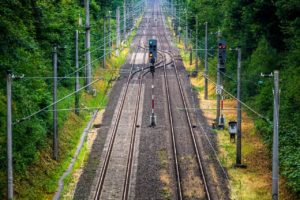Contamination
Managing contaminated land in the rail sector
According to Part 2A of the Environmental Protection Act (1990), contaminated land is defined as “any [land] which appears to the local authority in whose area it is situated to be in such a condition, by reason of substances in, on or under the land, that – a) harm is being caused; or a) there is a significant possibility of harm being caused…”. But how does contaminated land affect rail organisations, and how can employers effectively manage the level of risk? The experts at SOCOTEC take a look at these affects and managing the risk.
Where can contaminated land be located on railway sites?
 Railway environments are used for a host of different purposes, including fuel storage and handling, vehicle maintenance, waste disposal, demolition and chemical processing, all of which can produce unwanted material and contaminate the surrounding environment. Contamination could be a recent occurrence, and it may be ongoing, but in many cases contamination on railway land is a result of over a hundred years of industrial usage. Therefore, rail organisations need to be aware of the risks that contaminated land poses to workers, passengers and the surrounding wildlife/environment.
Railway environments are used for a host of different purposes, including fuel storage and handling, vehicle maintenance, waste disposal, demolition and chemical processing, all of which can produce unwanted material and contaminate the surrounding environment. Contamination could be a recent occurrence, and it may be ongoing, but in many cases contamination on railway land is a result of over a hundred years of industrial usage. Therefore, rail organisations need to be aware of the risks that contaminated land poses to workers, passengers and the surrounding wildlife/environment.
Examples of potential contaminants of soil and ballast on railway sites include:
• Coolants
• Hydrocarbons
• Cleaning chemicals
• Solvents
• Pesticides
• Asbestos-containing materials
• Contamination from ash/fill materials
• Polychlorinated biphenyls (PCBs)
• Migration of liquid, gas, vapours (including those dissolved in groundwater)
• Windblown dust
Why are environmental consultancy services important in the rail sector?
Environmental consultancy services provide support with compliance with environmental and waste management legislation, as well as the control of environmental and human health risks during depot and track enabling works. They also ensure cost-effective management of contaminated soils/ballast, maximising opportunities for reuse where possible.
Benefits of on-site testing/mobile labs for the rail sector include:
• Increased density of data
• Reactive sampling strategy
• Plume delineation
• Reduce SI phases
• Combine with rapid sampling techniques
• Earthworks and remediation
• Targeted excavation
• Materials sentencing
• Excavation validation
• Waste segregation
• Soil/ballast treatment management
• Waste classification and reduction
• Minimise hazardous waste
• Maximise materials re-use (CLAIRE Code of Practice)
• Health and safety
• Identify hazardous materials
• Zone sites for PPE/RPE controls
• Combine with real time atmospheric monitoring
• Water discharge monitoring
• Confirm holding lagoon/tank quality prior to discharge
• Refine treatment processes
What legislation and guidance should rail organisations consider when managing contaminated land?
Organisations must be mindful of the planning of policy and specific conditions when dealing with potentially contaminated land. There is a range of guidance and documentation that employers – including those operating in the rail sector – must adhere to when managing contaminated land, such as:
• Waste framework directive and WM3
• Network Rail Used Ballast Handling guidance document (NR/L3/ENV/044)
• Environmental Protection Act
• Water Framework Directive
Are there any noteworthy projects that SOCOTEC’s Contaminated Land Consultancy has been involved in on the railway?
 SOCOTEC’s Contaminated Land Consultancy can investigate and advise on contaminated land within a host of different environments (including the railway), offering such services as groundwater contamination investigations, waste management and environmental monitoring. Our team of experts have worked across a range of rail-related projects featuring land that could be potentially contaminated, many of which are located on existing or former railway sites.
SOCOTEC’s Contaminated Land Consultancy can investigate and advise on contaminated land within a host of different environments (including the railway), offering such services as groundwater contamination investigations, waste management and environmental monitoring. Our team of experts have worked across a range of rail-related projects featuring land that could be potentially contaminated, many of which are located on existing or former railway sites.
The Contaminated Land Consultancy recently contributed to the construction of a new bridge on an A road at a major station in the Midlands. As part of this project, earthworks were implemented to remove a road embankment that extracted buried drums, vehicle parts and contaminated soils and liquids. In light of this, there were concerns over soil and water contamination impacting the health of workers, the environment and the classification of waste.
SOCOTEC investigated the extent of the contamination with trial pits, boreholes and monitoring wells. Two mobile laboratories were set up on the site (either side of carriageway) to undertake waste classification and analysis of the soils and groundwater arising during piling operations. SOCOTEC also subcontracted a waste specialist for contaminated soil disposal and remediation of the drum area. On-site data helped to control costs by enabling segregation and a re-use of cleaner soils, minimising hazardous waste volumes.
How can SOCOTEC support rail organisations with their contaminated land requirements?
SOCOTEC offers a breadth of services to support organisations with their contaminated land requirements, including:
• Phase 1 (desk based) and Phase 2 (intrusive) investigations
• Waste classification including soils and ballast
• Water, gas and air monitoring
• Asbestos in soils advice
• Risk assessments
• Human health/controlled waters
• Construction phase and end use
• Remediation design
• Construction phase site support
• Supervision and verification
• Regulator liaison and discharge of planning conditions
Managing contaminated land in the rail sector
How does contaminated land affect rail organisations, and how can employers effectively manage the level of risk? The experts at SOCOTEC take a look.
Safety & Health Practitioner
SHP - Health and Safety News, Legislation, PPE, CPD and Resources Related Topics
How to safely use and store lithium-ion batteries in the workplace
‘My feet slid around and my legs hurt from gripping my toes’: Jane Middleton on ill-fitting PPE
Asbestos cement products – A low risk material?


